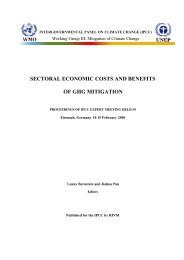Pacific Islands Environment Outlook - UNEP
Pacific Islands Environment Outlook - UNEP
Pacific Islands Environment Outlook - UNEP
Create successful ePaper yourself
Turn your PDF publications into a flip-book with our unique Google optimized e-Paper software.
38<br />
POLICY RESPONSES<br />
Governments have also shown a commitment to<br />
improved forestry practices, particularly in the larger<br />
island countries. National forestry action programmes (in<br />
Fiji and PNG), national forest resource inventories (Fiji,<br />
PNG, Samoa, Solomon <strong>Islands</strong>, Vanuatu), codes of<br />
logging practice and forest policy/legislation reviews<br />
(several countries) have been among the measures taken.<br />
In the smaller island countries, the response has<br />
included watershed management programmes and<br />
expanded reforestation and agroforestry initiatives. In all<br />
countries, governments have increased their support for<br />
the non-timber forest products subsector.<br />
EIA-related regulations exist in at least nine other<br />
<strong>Pacific</strong> countries, but implementation and enforcement<br />
remains weak, with provisions inserted in uncoordinated<br />
sectoral laws. Vanuatu is one of the few<br />
countries to have established an inter-agency<br />
committee for assessments (Rural Lands Development<br />
Committee). Given limited country capacities,<br />
assessments in even the more established countries of<br />
PNG and Fiji are of the order of only 3–6 per year.<br />
Some countries, such as Solomon <strong>Islands</strong> and FSM<br />
have EIA requirements as part of legislation to<br />
control foreign investment but these are also<br />
inadequately implemented. Guam’s local EIA<br />
requirements have been applied for eight years and,<br />
although 1998 was a very slow year for development,<br />
17 EIAs were reviewed.<br />
Draft laws that seek to co-ordinate all environment<br />
and conservation related issues have either been<br />
passed, exist or are in the pipeline in Fiji, Solomon<br />
<strong>Islands</strong>, PNG, Kiribati, Niue, Samoa, Cook <strong>Islands</strong>,<br />
Nauru and Vanuatu. In Fiji the detailed provisions of<br />
the Sustainable Development Bill are now being<br />
enacted in parts, with the first such enactment in 1998<br />
relating to implementation of obligations under the<br />
Ozone and Montreal agreements. Despite the<br />
significant implementation score for ozone-related<br />
MEAs in the region, only PNG (1997) and Fiji (1998)<br />
have enacted legislation.<br />
In response to waste management problems, many<br />
PICs have developed and enacted legislation that<br />
addresses litter (e.g. Fiji’s Litter Decree of 1991); local<br />
councils have been empowered to provide sanitary<br />
services dealing with rubbish (Kiribati’s Local<br />
Government Act of 1984); and Public Health Acts (Papua<br />
New Guinea, Solomon <strong>Islands</strong>) have provided<br />
mechanisms for regulating and controlling domestic<br />
refuse, as well as covering health, sanitation, scavenging<br />
and disposal of waste. Some PICs are also working<br />
towards specific legislation regarding waste management.<br />
For example, the Fijian authorities have included a<br />
comprehensive section on waste minimization and<br />
management as a component of their overall draft<br />
sustainable development legislation, which is currently<br />
being considered by cabinet. It is expected that the<br />
legislation will be approved in mid-1999.<br />
A further example of the use of legislation is the<br />
use of village by-laws in Samoa. These have been passed<br />
to create no fewer than 60 village fishery reserves<br />
ranging in size from 1 500 to 16 000 m 2 . Other<br />
legislation is more conventional and gives effect to EIA<br />
and the establishment of various types of Protected<br />
Areas (Boer 1993).<br />
Like other regions, the <strong>Pacific</strong> faces the<br />
‘implementation gap’. This means that the policies that<br />
are on paper or in the statute book may not be<br />
implemented in a consistent way and may, in the worst<br />
cases, be completely bypassed (SPREP 1992). Not<br />
surprisingly, this arises when the pressure to reap an<br />
economic benefit by rapid resource extraction is too<br />
great, and when governments are reluctant to slow<br />
down a project by sticking to the letter of<br />
environmental regulation.<br />
Institutional and legal framework at<br />
regional level<br />
The <strong>Pacific</strong> region has many regional organizations. The<br />
primary organizations are listed below (for further<br />
details see Box 2.4):<br />
●<br />
●<br />
●<br />
●<br />
●<br />
●<br />
●<br />
●<br />
South <strong>Pacific</strong> Regional <strong>Environment</strong> Programme<br />
(SPREP);<br />
Forum Secretariat (FS);<br />
Forum Fisheries Agency (FFA);<br />
South <strong>Pacific</strong> Applied Geoscience Commission<br />
(SOPAC);<br />
Secretariat of the <strong>Pacific</strong> Community (SPC);<br />
Tourism Council of the South <strong>Pacific</strong> (TCSP);<br />
University of the South <strong>Pacific</strong> (USP);<br />
<strong>Pacific</strong> Island Development Programme (PIDP).<br />
The implementation of Agenda 21 and the Barbados<br />
Plan of Action requires these organizations, with often<br />
narrow sectoral mandates, to co-ordinate their activities<br />
and collaborate actively on projects. Since the Earth<br />
Summit, collaboration between regional organizations in<br />
the <strong>Pacific</strong> has increased (Miles 1994). The Council of<br />
Regional Organizations for the <strong>Pacific</strong> (CROP), formerly<br />
the South <strong>Pacific</strong> Organizations Coordinating

















